Michelle Proksell: Where in China did you grow up? Do you think the environment you grew up in influenced your willingness to engage in digital art, or was there something else specifically that drew you to make the kind of artworks you do now?
Wang NewOne: I grew up in Shanghai, but I don’t think there is any direct relationship between my practice now and where I grew up. About what influenced me to engage in digital art… I think it has to do with anime and game culture. My engagement with the latter came later in retrospect, but my passion for anime and manga has had an affect on my whole upbringing. Not only did it influence my visual aesthetics and expressions, more importantly it introduced me to the virtual world, and I have since been obsessed with it. Then there was my developing interest in the gaming culture too. I think the combination of these two had essentially influenced my way of thinking altogether, a way of thinking that is originated from virtual reality.
The current era of digital networks has provided huge creative freedom for this way of thinking. On top of that there is the continual upgrade of all sorts of software. A lot of ideas that were difficult to realize in the past have finally become possible through new technologies. Another important factor is the brand new virtual reality digital products, the best example would be the Oculus Rift. It was about two years ago that I first used the test version of the Rift. Although there were aspects of the experience that still needed to be perfected, for me it was a revolutionary sensory experience. It allowed me to see the creative freedom and possibilities in virtual reality for the future. I think that experience had a significant impact on my creativity and thinking process.
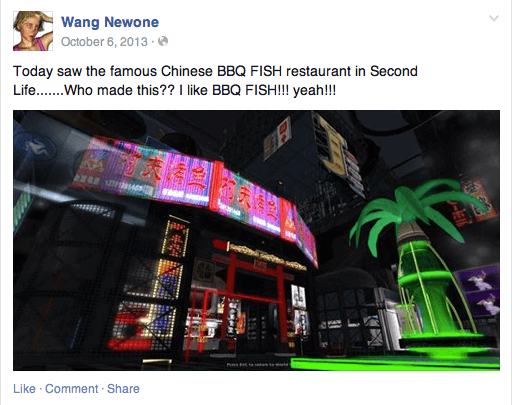
MP: When did you first use a computer and what are your earliest memories of using technology?
WNO: This is a brilliant question! I remember it was 1994, I was still very young, and my father had bought his first personal computer then, and so it was also my first computer. I remember it was a self-assembled kind of computer. At that time branded computers [in China] were still very expensive, so my father asked his friend who was working in a computer company to assemble this computer. It had a 14-inch colour monitor, Intel 180486 processor, and ran on a DOS operating system.
Thinking about the DOS operating system now it was really quite complicated, especially for someone who was bad at science like myself. It was agonizing for me to have to run DOS commands for everything in that system. I remember we had a notebook at home at the time, where my father would note down all sorts of DOS commands. Basically every time when I had to use the computer I had to refer to the commands in that notebook, so it was very inefficient. And that’s how I lost interest in that computer, it was mainly for my father’s work anyways.
Then in 1996 my father assembled a new computer, the processor was upgraded to Intel Pentium and operating system to Windows 3.1, and soon after it was upgraded to Windows 95. I think it was definitely the upgrading of the operating system that got me interested in computers again. I remember clearly the first time when I used the Windows system, it was an amazing feeling to be able to just close the window by clicking on the X on the top right corner.
MP: What did you think the internet was when you first heard about it, before actually going online? How did you hear about it?
WNO: I can’t quite recall when that would be, but it must be from the news on the TV. Before going online, the internet sounded really mysterious, since it’s not a physical thing that you can see or touch, just something that you would
hear about from time to time. I can’t really say I thought much about it. Though subconsciously I thought the name “internet” was quite commercial. Haha.
MP: What are your early memories of accessing and using the internet in China when you first started going online?
WNO: I suppose the earliest memory would be Myspace. Before then I was following some BBS’s about anime and music. It’s strange thinking about it, but I’ve never really used Douban, which is one of the most influential social platforms in China, I don’t even have an account. Myspace was the first social network that I engaged with, then I stopped using that for some reason, I guess it was after Facebook. The internet develops in such a quick pace, there are so many details that I can’t even remember clearly. Thinking about it now, Myspace feels like an invention from half a century ago, haha, perhaps that was too exaggerated, but it does feel that way.
MP: What is your current relationship to the internet outside of the Great Fire Wall?
WNO: My work computer is on 24 hours a day nowadays, also my VPN, so I’m constantly connected to the internet outside of the GFW, I only turn the VPN off when I have to access certain local Chinese websites. The first thing I do after waking up is run the VPN connection test program, checking all the connection speeds in all the countries around the world, then I pick the fastest one to use. Sometimes it takes a few switches a day, but looking at it optimistically, it makes life interesting, accessing a VPN in different countries everyday. But we all know that this is a stark choice that we are left with.
Some important global websites such as Facebook, Soundcloud, Gmail, Google and Youtube are currently censored by the GFW. This worries me sometimes. If the VPN finally stops working one day, I would lose all connection to the internet, which is a very probable situation.
MP: What is your current relationship to the Chinternet inside the Great Fire Wall? Do you navigate the different Webs for different reasons?
WNO: To be honest, in terms of work, I get all my information from websites overseas. My default search engine is Google, and if I want to look something up and learn about it, I would use Wikipedia or watch tutorials on Youtube. But please don’t misunderstand this as disregarding the local internet. I have looked up things on Baidu too, and I have watched tutorials on Youku and Tudou, but the quality of information was almost always disappointing. Let me give a simple example, if your looking for the same image, and you can find it up to 2500px,
or even higher, if you search on Google, but if you use Baidu, the largest you can find is probably 800px or 1000px. On top of that there is just a lot of information that wouldn’t even come up in a search. So instinctually I go for the more advanced and high quality web tools. I think perhaps a lot of Chinese citizens haven’t actually acknowledged this problem, because they have been using Baidu from the beginning and are just unaware of the world outside of Baidu, and they probably just buy things on Taobao and look for restaurants on Dianping. Weibo used to be so popular, and I have stopped using it a few years ago. Wechat is what I use the most, and there have been more and more interesting information circulating on Wechat, but its biggest problem is that your interaction is confined by the contacts you have, which are basically people you know in real life, this is what I find boring about it, I wish I could interact with more interesting strangers on Wechat.
MP: How did you come to start working in 3D? What were you producing before you started working on your new digital artworks?
WNO: It was about half a year ago that I started learning 3D rendering on my own. The works that I have on my Tumblr page now are all things that I made while learning the program in the past half year. There isn’t much, and most of it isn’t quite at the quality level that I hoped for. But this all comes to my technical abilities. Learning to use 3D software is much more difficult than I anticipated. It’s not like with Photoshop or Illustrator where you can improve your skills in a short amount of time.
Before all this, I was painting a lot. I was trained in Chinese traditional painting in college, but I haven’t produced much work. After graduating I was teaching myself how to use some software, then I started to collaborate with some local musicians (in Shanghai), designing event posters, some CD covers, T-shirts and stickers etc. During this time I also learned how to screen print, and have produced some prints, but not so many of them. Overall speaking, I never had a common thread in my works over the years, they were mostly emotional and casual. And now with the 3D works that I’m making, my thinking process has become very different from before, I have a few clearer topics that I like to address in my practice, and will make plans to realize them in different stages.
MP: Who is this ebola virus 3D model you created and where did the idea to design her come from?
WNO: I made this model totally randomly without any plans. I make lots of this kind of random models just to see if I can use them in the future and most of them I haven’t put online yet. The Ebola pattern on the clothing was also half random. I collected lots of 3d virus model pictures because I really like those Medical science images. I’ve been collecting those things for long long time now. The virus stuff is just a part of my collection, and that day I used the Ebola pattern because during the time it was a popular topic, so the Ebola model looks very cool. So I didn’t put much meaning into the whole thing with the girl in Ebola clothing, for me it just looks cool like that. But on the other hand, after people have seen it they might think of something based on their own perspective and relationship to it, and that’s what I want from this work.
MP: What do you think your relationship is to the art world?
WNO: Do you mean the art world in relation to the system? If so, I don’t think I have much to do with this world, and I have never thought about having anything to do with it. Initially I was not so aware of how artworks develop in the system, but through recent encounters I have slowly started to know about some of the people and incidents happening in this system. Now I have even less desire to have anything to do with this “art world”. Perhaps I am instinctually repulsed by this system.
MP: Do you consider yourself an artist, designer, creator or something else?
WNO: It’s hard to say what one role I would like to play. Ideally I would be playing a lot of different roles in virtual reality, presenting myself in different physical forms and identities, creating different things to share with everyone.
And in terms of myself in real life outside of the virtual world, I think she would get smaller and smaller, until she disappears.
媚潇:你在中国哪里长大的?你觉得你成长的环境有影响到你对数字艺术的兴趣么,还是有别的原因导致你做现在这种创作?
王新一:我在上海长大,不过我想我现在的创作和我在哪里长大没有多大关系。要说是什么影响了我对数码艺术的兴趣? 我想是日本的动漫和游戏文化。相对来说对游戏的接触稍晚一些,但对于日本动漫和漫画的热爱可以说是影响了我的整个成长过程。 它不仅仅影响了我在视觉方面的审美与表达,更重要的是它开启了我对虚拟世界最初的向往及之后义无反顾地追随与热爱。加上之后对游戏文化的逐步接触,我想这两者的结合从根本上影响了我的思维方式,一种直接从虚拟现实角度出发的思维方式。
而现在的网络数字时代给这种思维方式提供了极大的创作空间,再加上如今各种数码软件在技术上的不断更新,你会发现许多在过去看来不可能或很难实现的创作想法,现在通过各种新的技术可以被越来越多的表达出来了。 另外,十分重要的,要说到一些刚被发明出来的虚拟现实数码产品。最好的例子应该就是Oculus Rift,大概是在两年前,我第一次试用了Rift一代的测试版本,虽然在使用体验上还有许多方面有待完善,但对我来说那是一次革命性的新感官体验,它让我看到了在未来虚拟现实无限大的创作空间及可能性。我想那一次体验对我现在的创作方向及思维模式有着极大的影响。
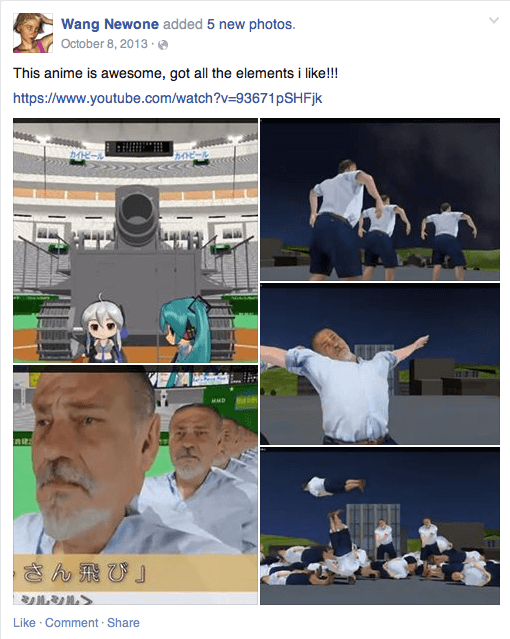
媚潇: 你第一次用电脑是什么时候?你最早用科技的记忆又是什么?
王新一: 哈哈,这个问题太好了!记得那是1994年,当时我还很小,我的父亲购置了他人生中的第一台电脑,那也是我的第一台电脑。 记得那是一台组装的电脑,因为当时品牌电脑的价格还十分昂贵,所以我父亲拜托他在电脑公司工作的朋友组装配置了这台电脑。显示器是14寸的彩色的,处理器是Intel80486,操作系统是 DOS。
现在回想起DOS操作系统的使用真是十分复杂,尤其因为我是一个理科特别差的人,DOS系统中每一步都需要输入DOS命令的操作方法对我来说简直就是煎熬。记得当时家里有一本笔记本,上面都是我父亲手写的各种DOS命令,基本上每次使用电脑我都需要对照着笔记本输入命令公式,所以效率极低。也因此我当时对这台电脑没多大兴趣,它主要还是为我父亲的工作服务。
后来大概是在1996年,父亲又从新配置了一台电脑,处理器换了Intel Pentium, 操作系统也换成了Windows 3.1 ,之后又很快地换成了Windows 95。我想正是操作系统的改变极大地增强了我对电脑的兴趣! 记忆最深刻的是,第一次使用Windows系统时,鼠标点击视窗右上角的叉就可直接退出,这让我感觉太棒了!
媚潇:你刚听说有互联网而没有接触过它的时候你认为它是什么,从哪里得知有互联网?
王新一: 恩,刚听说有互联网是什么时候?现在已经记不清了,应该是在电视新闻中得知的吧。没有接触之前就觉得互联网听上去很神秘,因为它不是一个实物,你看不见也摸不着它,只是偶尔听到这个名词,也说不上对它有什么样特别的感觉。不过当时我潜意识里觉得互联网这个词感觉挺商务的。哈哈。
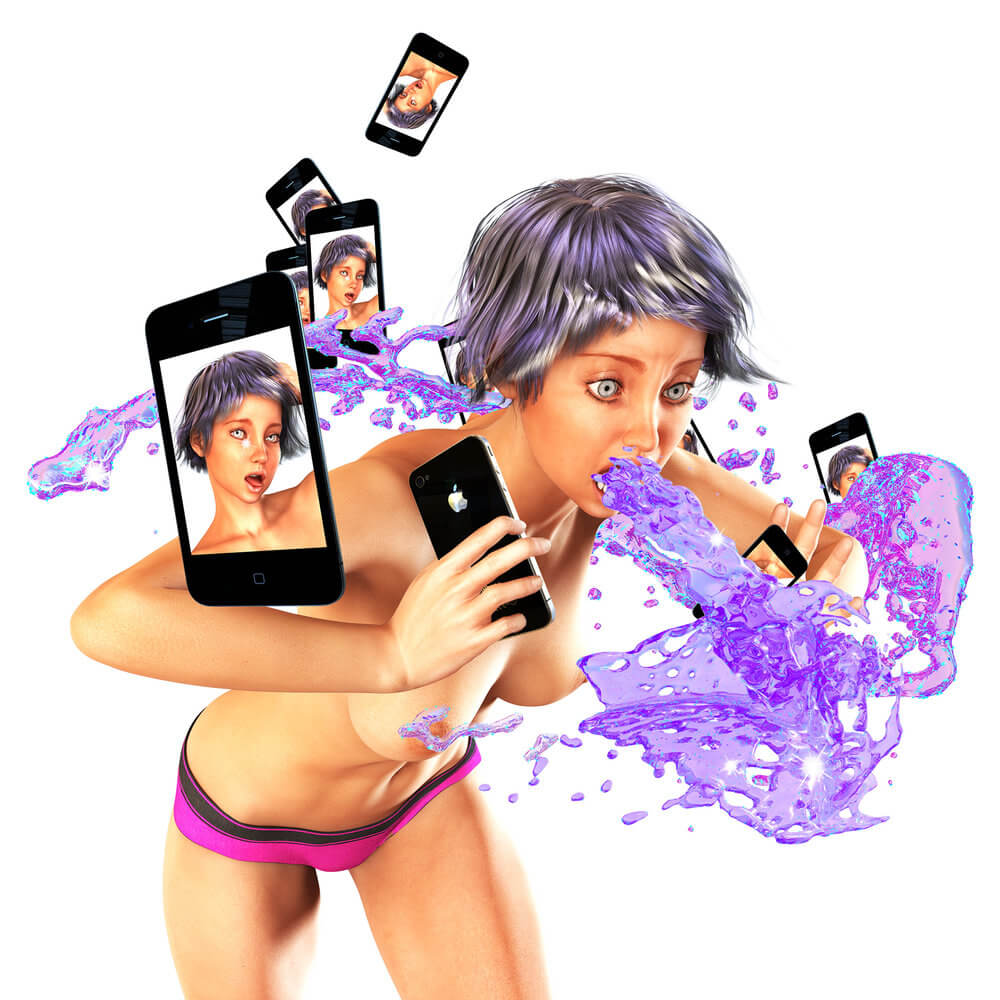
媚潇:你最早在国内接触互联网的记忆是什么?
王新一:最早的记忆应该是Myspace吧。在那之前也已经开始关注一些动慢或音乐方面的BBS论坛。说来也怪,在中国影响力很大的豆瓣网我一直都没怎么用过,到现在连帐号都没有。 而Myspace算是我最初接触的社交网络了,再后来什么时候开始不用了也记不清了,应该是开始用了Facebook之后吧。互联网的发展太快了,很多细节都记不清了。现在回想起来,感觉Myspace好像是50年前的产物了,哈哈,也许说得有点夸张了,但确实是这种感觉。
媚潇:现在你与中国国家防火墙(GFW)外的互联网是什么关系?
王新一:我的工作电脑现在每天24小时处于开机状态,同时VPN也是一直打开着,所以和GFW以外的互联网一直保持着连接状态,只有在需要使用某些国内网站的情况下才会断开一会儿。现在每天醒来的第一件事是打开VPN的测速系统,将分布在世界各地的站点速度都过一遍,然后选择速度最快的使用。有时一天要切换好几个不同国家的VPN,从积极的方面看,感觉这样的生活也挺有意思,每天穿越不同国家的VPN。但其实大家心里也都很明白,这只是我们一种无奈的选择。
像现在,Facebook、Soundcloud、Gmail、Google、Youtube等一些重要的全球性网站都被GFW给屏蔽了。有时候我真的很担心,如果有一天没有了VPN就会失去和所有这些网络的联系,这不是不可能会发生的事。
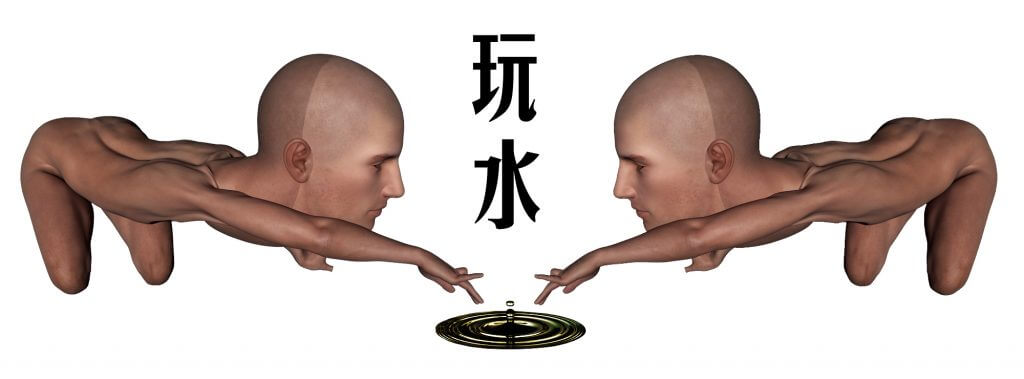
媚潇:你现时与中国的互联网又是什么关系?两个不同的互联网对你来说用途是否也不一样?
王新一:说实话,现在工作方面,资讯方面都是在使用国外的网络,基本的搜索肯定就是Google,如果要查资料学习的话就是Wikipedia 或者是上Youtube看教程。但请大家不要误会我,我并不是有意要排斥国内的网络,我也试过用Baidu搜索,也试过在Youku或Tudou 上看教程,但是得到的信息质量让我十分失望。举一个简单的例子,同样的一张图片,你用Google搜,也许最大可以找到2500pixels 或者更高清质量的,但用Baidu搜,通常最大就只能找到800或1000pixels左右的质量,而且许多重要的信息你根本就搜不到。 是我的本能让我选择了更为先进和高质量的网络工具。 我觉得许多中国人还没有意识到这个问题,因为他们从出生就是使用Baidu,对于Baidu 以外的世界他们不知道,也不想知道,这一点很可怕。 所以国内的互联网我确实用的不多,主要就是上淘宝网买东西,上大众点评网找地方吃饭。之前很火的微博,从好几年前我就完全不用了。现在用的最多的就是微信,最近在微信上看到越来越多有意思的内容,不过它最大的问题是朋友圈的范围被限制了很小,基本上都是在现实生活中认识的人,这让我感觉很无聊,我希望我的朋友圈能有更多有意思的陌生人参与进来。
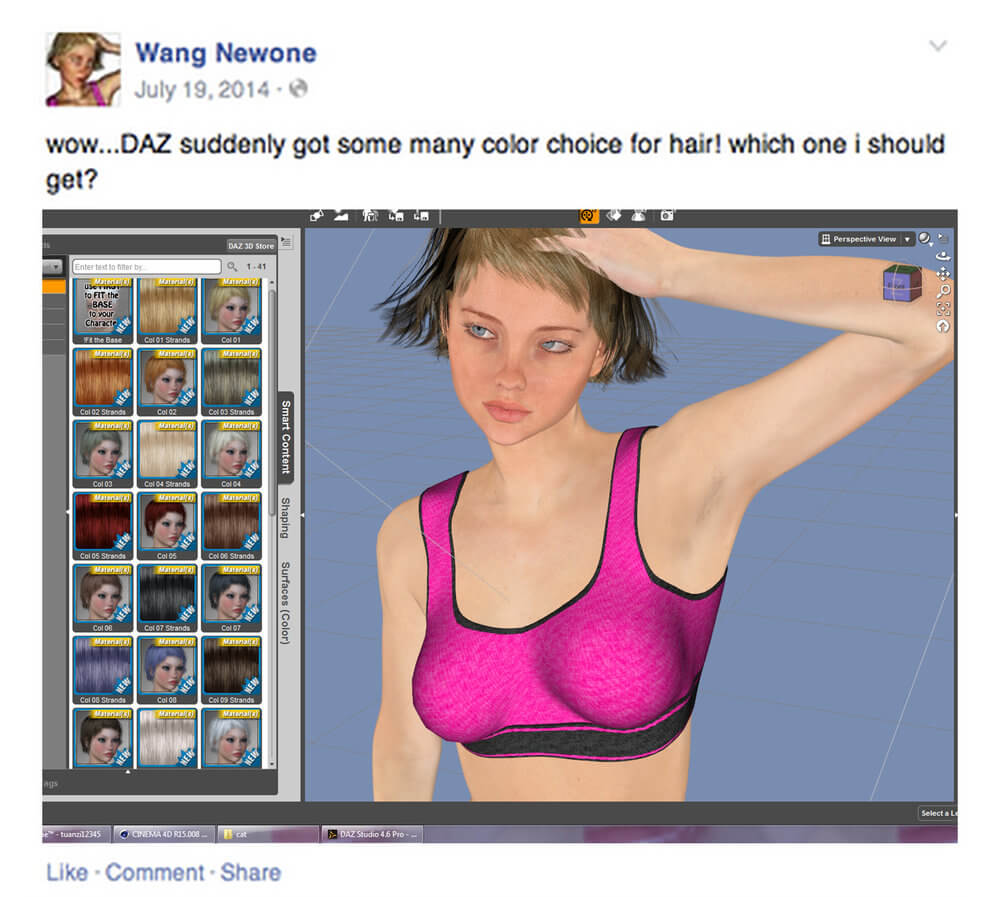
媚潇:你是怎么样开始做3D渲染的?在最近的创作之前你做的作品是怎样的?
王新一:大概是在半年前,我开始自学做3D渲染。现在Tumblr上我的这些作品,都是过去半年里边学习边创作的。其实数量还是很少,而且很多还是没有达到我理想中的效果。这还是和我的技术有关,3D软件的学习比我想象的要难得多,不像Photoshop或AI那样的软件可以在短时间里提高很快。
而在这之前,我有很长一段时间的绘画经历,我大学的专业是中国传统绘画,不过我并没有许多传统绘画方面的创作。毕业之后,先是自学了一些设计软件,后来开始和一些本土的音乐团体合作,设计了不少演出海报,也包括一些CD封面,Tee-shirt还有贴纸等等。期间,还学习了丝网版画,也有一些版画的作品,但数量不多。总体来说,我之前的作品没有一个长期固定的主题,感性的成分比较多,比较随意。 现在在做的这些3D渲染作品,从创作的思考角度上来说和过去很不一样,我有了几个比较明确的创作主题,并且想有计划地在未来分阶段完成。
媚潇: 谁是这个埃博拉病毒的3D角色,你设计她的灵感又来自哪里?
王新一:我没有特别计划做这个模型。我一般都是随意地做一些然后再决定要不要用它们,大部分都还没有在网上发布过。衣服上的埃博拉病毒图案也是半随意的。我很喜欢有关医学的图片,所以我收集了很多3D病毒图案。在很久以前我已经开始收集各种的素材,病毒只是其中一部分。我用了埃博拉病毒的图案,因为埃博拉当时是一个热门话题,那个埃博拉模型也因此看起来很酷。我没有多想穿着埃博拉病毒图案的女孩背后的意义,
对我来说,她就是看起来很酷。另一方面,我也希望看过的人能会根据他们自己的观点而解读她。
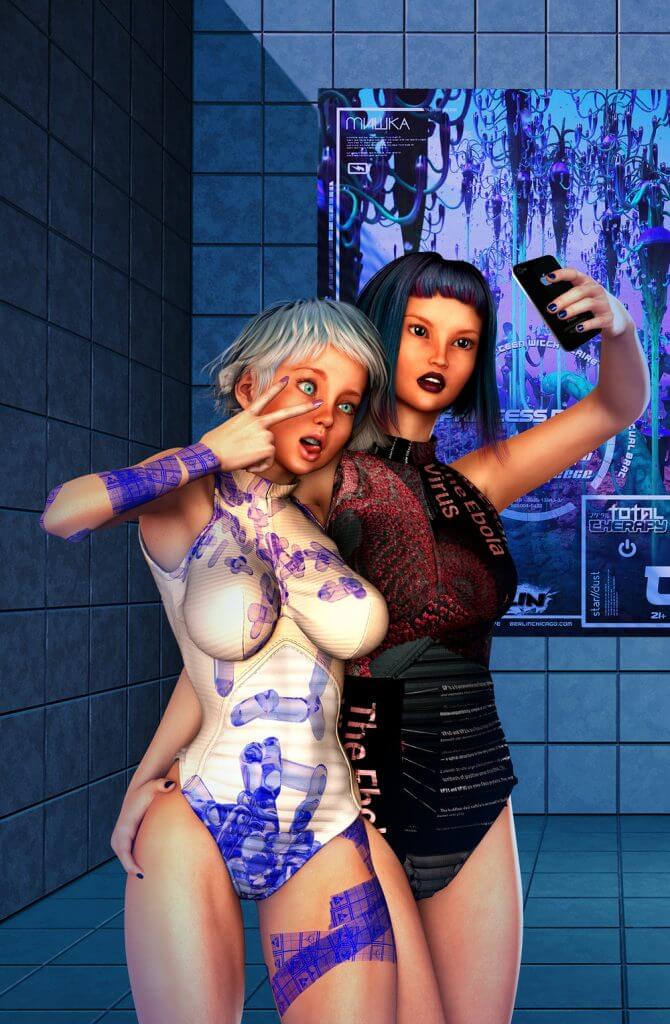
媚潇:你觉得你现在与整体艺术环境是什么关系?
王新一:你说的“艺术环境”是指体系中的艺术环境吗? 如果是,我想我和这个环境到现在还没有什么关系,我也从来没想过要和它有什么关系。原先我对艺术是如何在那个体系中运作发展的模式并不是很了解,不过最近通过一些机会我慢慢的接触了也解到了一些在这个体系中的人和事。了解后的感觉是,我更不想和这个“艺术环境”有关系了。 我觉得我对这个体系的环境有一种本能的抗拒感。
媚潇:你觉得你在扮演的是艺术家、设计师、创造者,还是什么角色呢?
王新一:我觉得很难说我想要扮演一个单一的什么样的角色。 我的理想是在虚拟现实的环境中,我可以扮演很多不同的角色,以不同的面目与身份出现,创作出不同主题的东西与大家分享。
而虚拟世界以外,现实生活中的我,我希望他会越变越小,最后慢慢地消失不见。
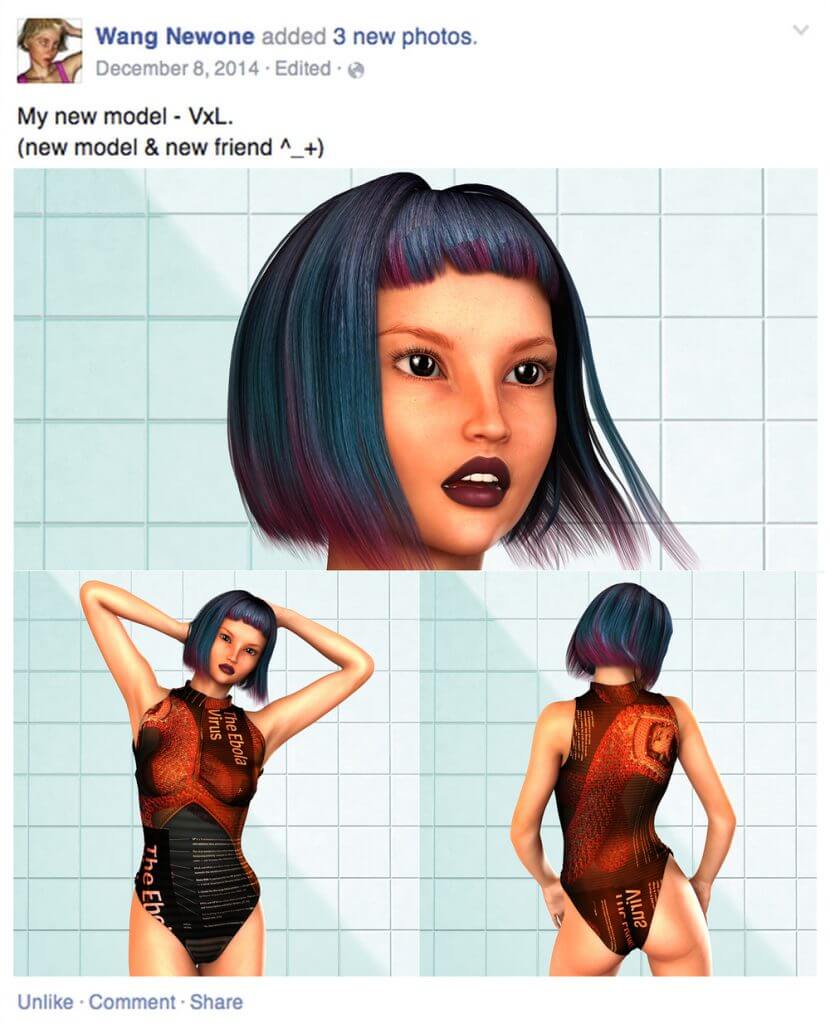
译本 / 陈秀炜
Chinese translations by Ophelia S. Chan